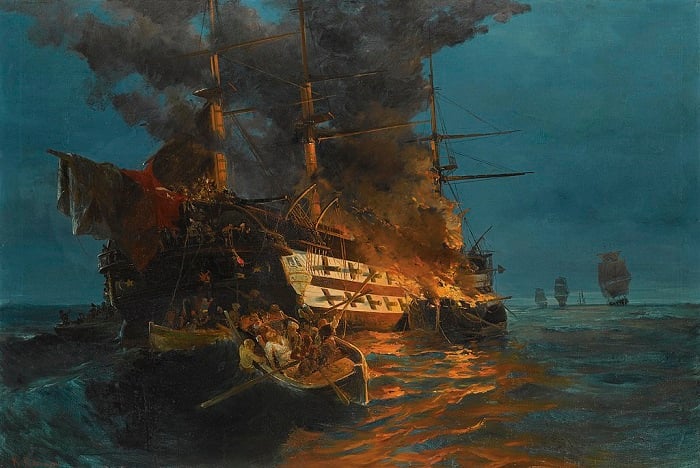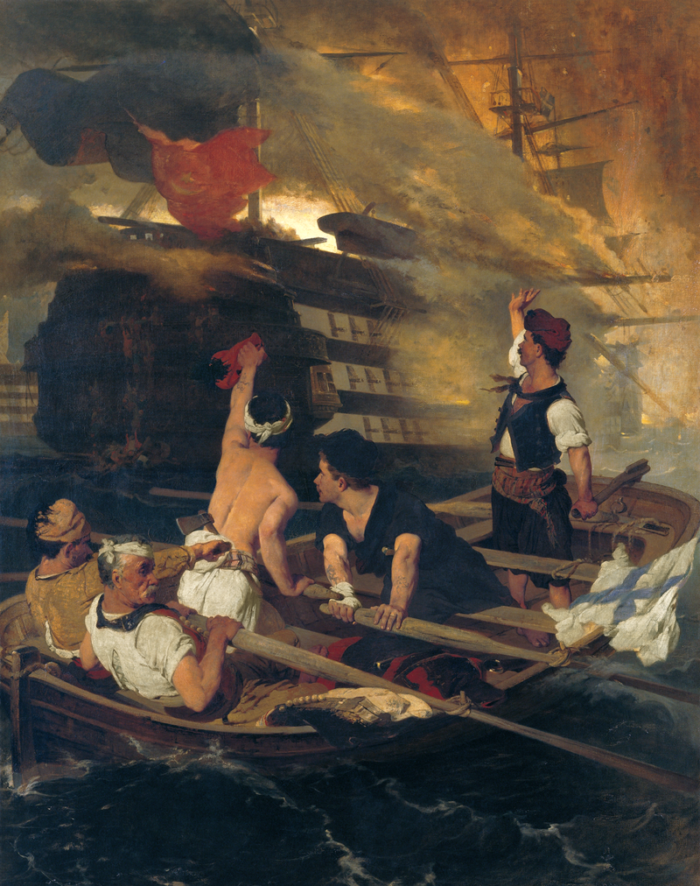
Silently, with mute prayers to St. Nicholas and the Virgin Mary during the Greek War of Independence, Greece’s islanders — from the small islands of Hydra, Spetses, and Psara — pilot their floating bomb towards a Turkish frigate.
The bomb — an old, aging ship, stripped of its fittings, filled with gunpowder and pitch, with tangling yardarms and tinder-dry canvas — only waits for the spark.
These were the fireships of the Greek War of Independence.
In early modern naval warfare, fireships had been used in many naval encounters, as a way for smaller, more nimble, better skilled fleets to counter the large traditional warships with their rows of cannon.
The technology is simple, and indeed fire as a naval weapon is as old as warfare itself.
Certainly, by 1821, most navies had countermeasures and the fireship was obsolete.
It was a weapon of necessity, which, although technically obsolete, was still used by the skilled sailors of the Greek Navy to a devastating, asymmetric effect.
Fireships tended to be older, smaller vessels, which were refurbished with combustibles, such as gunpowder and pitch, to basically become floating bombs.
All the rigging, along with their sails, might be doused with various materials, both to stoke the flames and to entangle with the target ship.
The fireship would have a skeleton crew who were among the most skilled and dedicated sailors, who would be able to get away using a small escape rowboat towed behind the fireship.
Hatches were cut at various intervals in the ships’ hulls to allow for air intake to feed the flames even further.

Fireships decisive in naval encounters during the Greek War of Independence
While Hydra and its fellow “nautical islands” in Greece, Spetses and Psara, possessed many ships manned by well-skilled crews, they did not have naval ships in the traditional sense.
Many of their merchant ships were armed with cannon; this was the Mediterranean Sea, of course, which was filled with pirate ships.
The Aegean islanders were not above piracy and blockade-running themselves, but the armed merchantmen, though common in nineteenth century naval warfare, lacked the punch of frigates.
Fireships were the obvious solution for the Greek islanders.
They were easy to procure and they had the skills and courage to use them effectively despite their clear limitations as weapons.
The proof was in the results for Greece
Greek fireships time and again proved decisive in naval encounters, destroying key Turkish naval assets, and, just as importantly, causing panic amongst the Turkish sailors.
Beyond the destruction of the valuable Turkish vessels, the threat of Greek fireships kept the Turks from effective movement in the Aegean.
They prevented the more active reinforcement of Turkish attempts to defeat the Greek Revolution on the Greek Mainland, which held out in spite of great odds (and plenty of internecine fighting).
The pilots of fireships were renowned for their dash, daring, and faith; they even attempted to burn the Egyptian Fleet (who were allies of the Turks) at Alexandria.
The day of the fireship was past; even at the end of the Greek War of Independence, steam-powered warships came onto the scene, as well as ironclads a few decades later.
The new Greek Navy would spend considerable amounts of the state budget to procure the ships needed for the country’s defense and expansion, at times assisted by her Diaspora.
Most notably in the purchase of the Battle Cruiser “Averoff,” which, commanded by a Hydriot admiral, battered the Turkish fleet in the Balkan Wars.
This made the land victories against the Turks more certain.
The fireship elan remains
In the Balkan Wars, too, a bit of the fireship elan remained when another Hydriot, Captain Nicholas Votsis snuck a torpedo boat into Thessaloniki harbor, which was at the time still under Turkish control, and sank the Turkish cruiser Fetih Bulend.
Hydriots honor the legacy of the fireships in the annual “Miaouleia” Festival, a celebration in Hydra’s beautiful amphitheatrical harbor which culminates in the burning and fireworks on a small ship.
This festival, renowned throughout Greece, even continued in the summer of 2020 — despite the restrictions of the Coronavirus pandemic.
For Hydra’s 2021 celebrations, to commemorate the Bicentennial of the Greek War of Independence, the festival is sure to be a key event.
Today, the Greek Navy is one of the world’s finest fleets, drawing on the skills of an ancient maritime nation and the inspiration of three thousand years of victories at sea.
Its ships tend to be nimble and smaller, its sailors learned and daring, and its tactics daring and asymmetric, as always.



Comments
Post a Comment